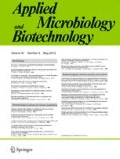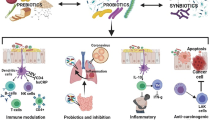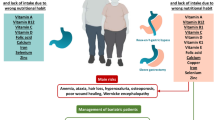Abstract
Consumption of fructose leads to metabolic syndrome, but it is also known to increase iron absorption. Present study investigates the effect of genetically modified Escherichia coli Nissle 1917 (EcN) synbiotic along with fructose on non-heme iron absorption. Charles foster rats weighing 150–200 g were fed with iron-deficient diet for 2 months. Probiotic treatment of EcN (pqq) and EcN (pqq-glf-mtlK) was given once per week, 109 cells after 2 months with fructose in drinking water. Iron levels, blood, and liver parameters for oxidative stress, hyperglycemia, and dyslipidemia were estimated. Transferrin-bound iron levels in the blood decreased significantly after 10 weeks of giving iron-deficient diet. Probiotic treatment of EcN (pqq-glf-mtlK) and fructose together led to the restoration of normal transferrin-bound iron levels and blood and hepatic antioxidant levels as compared to iron-deficient control group. The probiotic also led to the restoration of body weight along with levels of serum and hepatic lipid, blood glucose, and antioxidant in the blood and liver as compared to iron-deficient control group. Restoration of liver injury marker enzymes was also seen. Administration of EcN-producing PQQ and mannitol dehydrogenase enzyme together with fructose led to increase in the transferrin-bound iron levels in the blood and amelioration of consequences of metabolic syndrome caused due to fructose consumption.








Similar content being viewed by others
References
Bailey RL, West KP, Black RE (2015) The epidemiology of global micronutrient deficiencies. Ann Nutr Metab 66:22–33. doi:10.1159/000371618
Bernat N, Chafer M, Chiralt A, Laparra JM, Martınez CG (2015) Almond milk fermented with different potentially probiotic bacteria improves iron uptake by intestinal epithelial (Caco-2) cells. Int J Food Stud 4:49–60
Brune M, Rossander-Hultén L, Hallberg L, Gleerup a, Sandberg a S (1992) Iron absorption from bread in humans: inhibiting effects of cereal fiber, phytate and inositol phosphates with different numbers of phosphate groups. J Nutr 122:442–449.
Camaschella C (2015) Iron-deficiency anemia. N Engl J Med 372:1832–1843. doi:10.1056/NEJMra1401038
Christides T, Sharp P (2013) Sugars increase non-heme iron bioavailability in human epithelial intestinal and liver cells. PLoS One. doi:10.1371/journal.pone.0083031
Costa NMB, Ybarra LM, Santos FL, Ramirez-Cárdenas L, Sant’ana LFR, Nobre LN, Pires ISC, Rosado EL, Ferreira ACR (2000) Modulação dos níveis de hemoglobina em ratos pelo consumo de probiótico (Lactobacillus acidophilus). XII Congreso Latinoamericano de Nutrición, Buenos Aires
Dell L (1993) Fructose and mineral metabolism. Am J Clin Nutr 58:7715–7785
Fischer MM, Egli IM, Aeberli I, Hurrell RF, Meile L (2014) Phytic acid degrading lactic acid bacteria in tef-injera fermentation. Int J Food Microbiol 190:54–60. doi:10.1016/j.ijfoodmicro.2014.08.018
Freitas KDC, Amancio OMS, Morais MB (2012) High-performance inulin and oligofructose prebiotics increase the intestinal absorption of iron in rats with iron deficiency anaemia during the growth phase. Br J Nutr 108:1008–1016. doi:10.1017/S0007114511006301
Gillooly M, Bothwell TH, Torrance JD, MacPhail AP, Derman DP, Bezwoda WR, Mills W, Charlton RW, Mayet F (1982) The effects of organic acids, phytates and polyphenols on the absorption of iron from vegetables. Br J Nutr 49:331. doi:10.1079/BJN19830042
Goossens D, Jonkers D, Russel M, Thijs A, van den Bogaard A, Stobberingh E, Stockbrügger R (2005) Survival of the probiotic, L. plantarum 299v and its effects on the faecal bacterial flora, with and without gastric acid inhibition. Dig Liver Dis 37:44–50. doi:10.1016/j.dld.2004.07.018
Haeri MR, Izaddoost M, Ardekani MRS, Nobar MR, White KN (2009) The effect of fenugreek 4-hydroxyisoleucine on liver function biomarkers and glucose in diabetic and fructose-fed rats. Phyther Res 23:61–64. doi:10.1002/ptr.2557
Hallberg L, Hulthén L (2000) Prediction of dietary iron absorption an algorithm for calculating absorption and bioavailability.pdf
Hallberg L, Hulthen L, Bengtsson C, Lapidus L, Lindstedt G (1995) Iron balance in menstruating women. Eur J Clin Nutr 49:200–207
Hallberg L, Rossander-Hulten L (1991) Iron requirements in menstruating women. Am J Clin Nutr 54:1047–1058
Hoppe M, Hulthén L, Hallberg L (2008) The importance of bioavailability of dietary iron in relation to the expected effect from iron fortification. Eur J Clin Nutr 62:761–769. doi:10.1038/sj.ejcn.1602776
Hoppe M, Önning G, Berggren A, Hulthén L (2015) Probiotic strain Lactobacillus plantarum 299v increases iron absorption from an iron-supplemented fruit drink: a double-isotope cross-over single-blind study in women of reproductive age. Br J Nutr 114:1195–1202. doi:10.1017/S000711451500241X
Kurtoglu E, Ugur A, Baltaci AK, Undar L (2003) Effect of iron supplementation on oxidative stress and antioxidant status in iron-deficiency anemia. Biol Trace Elem Res 96:117–123. doi:10.1385/BTER:96:1-3:117
Lindqvist A, Baelemans A, Erlanson-albertsson C (2008) Regulatory peptides effects of sucrose, glucose and fructose on peripheral and central appetite signals. 150:26–32. doi: 10.1016/j.regpep.2008.06.008
Lynch SR, Stoltzfus RJ (2003) Iron and ascorbic acid: proposed fortification levels and recommended iron compounds. J Nutr 133:2978S–2984S
Marciano R, Santamarina AB, de Santana AA, de Silva MLC, Amancio OMS, do Nascimento CM, Oyama LM, de Morais MB (2015) Effects of prebiotic supplementation on the expression of proteins regulating iron absorption in anaemic growing rats. Br J Nutr 113:901–908. doi:10.1017/S0007114514004334
Marriott BP, Olsho L, Hadden L, Connor P (2010) Intake of added sugars and selected nutrients in the United States, National Health and Nutrition Examination Survey (NHANES) 2003–2006. Crit Rev Food Sci Nutr 50:228–258. doi:10.1080/10408391003626223
Ogden CL, Kit BK, Carroll MD, Park S (2011) Consumption of sugar drinks in the United States, 2005–2008. NCHS Data Brief 1–8
Pandey S, Singh A, Kumar P, Chaudhari A, Nareshkumar G (2014) Probiotic Escherichia coli CFR 16 producing pyrroloquinoline quinone (PQQ) ameliorates 1,2-dimethylhydrazine-induced oxidative damage in colon and liver of rats. Appl Biochem Biotechnol 173:775–786. doi:10.1007/s12010-014-0897-z
Perez-Conesa D, Lopez G, Ros G (2007) Effect of probiotic, prebiotic and synbiotic follow-up infant formulas on iron bioavailability in rats. Food Sci Technol Int 13:69–77. doi:10.1177/1082013207075465
Raghuvanshi R, Chaudhari A, Nareshkumar G (2016) Amelioration of cadmium and mercury induced liver and kidney damage in rats by genetically engineered probiotic Escherichia coli Nissle 1917 producing pyrroloquinoline quinone (PQQ) with oral supplementation of citric acid. Nutrition. doi:10.1016/j.nut.2016.03.009
Reeves PG (1997) AIN-93 purified diets for the study of trace element metabolism in Rodnts.pdf. Methods Nutr. Res. 3–37
Saini RK, Manoj P, Shetty NP, Srinivasan K, Giridhar P (2014) Dietary iron supplements and Moringa oleifera leaves influence the liver hepcidin messenger RNA expression and biochemical indices of iron status in rats. Nutr Res 34:630–638. doi:10.1016/j.nutres.2014.07.003
Sazawal S, Dhingra U, Hiremath G, Sarkar A, Dhingra P, Dutta A, Menon VP, Black RE (2010) Effects of Bifidobacterium lactis HN019 and prebiotic oligosaccharide added to milk on iron status, anemia, and growth among children 1 to 4 years old. J Pediatr Gastroenterol Nutr 51:341–346. doi:10.1097/MPG.0b013e3181d98e45
Schaefer EJ, Gleason JA, Dansinger ML (2009) Dietary fructose and glucose differentially affect lipid and glucose homeostasis1–3. J Nutr 139:1257S–1262S. doi:10.3945/jn.108.098186.WHO
Scheers N, Rossander-Hulthen L, Torsdottir I, Sandberg AS (2016) Increased iron bioavailability from lactic-fermented vegetables is likely an effect of promoting the formation of ferric iron (Fe3+). Eur J Nutr 55:373–382. doi:10.1007/s00394-015-0857-6
Singh AK, Pandey SK, Naresh Kumar G (2014) Pyrroloquinoline quinone-secreting probiotic Escherichia coli Nissle 1917 ameliorates ethanol-induced oxidative damage and hyperlipidemia in rats. Alcohol Clin Exp Res 38:2127–2137. doi:10.1111/acer.12456
Singh AK, Pandey SK, Saha G, Gattupalli NK (2015) Pyrroloquinoline quinone (PQQ) producing Escherichia coli Nissle 1917 (EcN) alleviates age associated oxidative stress and hyperlipidemia, and improves mitochondrial function in ageing rats. Exp Gerontol 66:1–9. doi:10.1016/j.exger.2015.04.001
Somabhai CA, Raghuvanshi R, Nareshkumar G (2016) Genetically engineered Escherichia coli Nissle 1917 synbiotics reduce metabolic effects induced by chronic consumption of dietary fructose. 1–15. doi: 10.1371/journal.pone.0164860
Stanhope KL (2012) Role of fructose-containing sugars in the epidemics of obesity and metabolic syndrome. Annu Rev Med 63:329–343. doi:10.1146/annurev-med-042010-113026
Suwannaphet W, Meeprom A, Yibchok-Anun S, Adisakwattana S (2010) Preventive effect of grape seed extract against high-fructose diet-induced insulin resistance and oxidative stress in rats. Food Chem Toxicol 48:1853–1857. doi:10.1016/j.fct.2010.04.021
Tanko Y, Adamu BY, Mohammed KA, Jimoh A, Abdulrazak A, Sada NM, Yerima M (2013) Ameliorative effect of ethanolic extract of Caralluma diazielli on serum liver enzymes on fructose induced diabetic in wistar rats. Der Pharm Lett 5:254–258
Tappy L, Le K-A (2010) Metabolic effects of fructose and the worldwide increase in obesity. Physiol Rev 90:23–46. doi:10.1152/physrev.00019.2009
Tsuchiya H, Ebata Y, Sakabe T, Hama S, Kogure K, Shiota G (2013) High-fat, high-fructose diet induces hepatic iron overload via a hepcidin-independent mechanism prior to the onset of liver steatosis and insulin resistance in mice. Metabolism 62:62–69. doi:10.1016/j.metabol.2012.06.008
Walter PB, Knutson MD, Paler-Martinez A, Lee S, Xu Y, Viteri FE, Ames BN (2002) Iron deficiency and iron excess damage mitochondria and mitochondrial DNA in rats. Proc Natl Acad Sci U S A 99:2264–2269. doi:10.1073/pnas.261708798
White JS (2008) Straight talk about high-fructose corn syrup: what it is and what it. Am J Clin Nutr 88:1716S–1721S. doi:10.3945/ajcn.2008.25825B.2
Whitton C, Nicholson SK, Roberts C, Prynne CJ, Pot GK, Olson A, Fitt E, Cole D, Teucher B, Bates B, Henderson H, Pigott S, Deverill C, Swan G, Stephen AM (2011) National Diet and Nutrition Survey: UK food consumption and nutrient intakes from the first year of the rolling programme and comparisons with previous surveys
Yeung C, Glahn RP, Welch RM, Miller DD (2005) Prebiotics and iron bioavailability—is there a connection ? J Food Sci 70:88–92
Acknowledgement
We are grateful to Dr. Rer. Nat. Ulrich Sonnenborn, Ardeypharm GmbH, Loerfeldstrabe 20, Herdecke (Germany), for providing the Escherichia coli Nissle 1917 and the DBT-ILSPARE program for carrying out real-time PCR.
Author information
Authors and Affiliations
Corresponding author
Ethics declarations
Funding
Archana Somabhai Chaudhari and Ruma Raghuvanshi are supported by Senior Research Fellowship of Department Of Biotechnology (DBT-JRF/2011–12/304) and Indian Council Of Medical Research (3/1/3/JRF-2012/HRD), respectively.
Conflict of interest
The authors declare that they have no conflict of interest.
Ethical approval
All applicable institutional guidelines for the care and use of animals were followed.
Rights and permissions
About this article
Cite this article
Chaudhari, A.S., Raghuvanshi, R. & Kumar, G.N. Genetically engineered Escherichia coli Nissle 1917 synbiotic counters fructose-induced metabolic syndrome and iron deficiency. Appl Microbiol Biotechnol 101, 4713–4723 (2017). https://doi.org/10.1007/s00253-017-8207-7
Received:
Revised:
Accepted:
Published:
Issue Date:
DOI: https://doi.org/10.1007/s00253-017-8207-7




